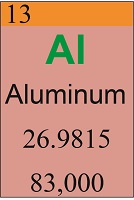
Aluminum (Al):
During WWII, an attempt was made to extract aluminum from anorthosite in the Laramie Mountains. The anorthosite contains as much as 27–30 percent alumina,
with typical analyses showing 25.87 percent Al2O3. An extraction process was developed by the Monolith Portland Midwest Co., and a plant was constructed near Laramie. However,
there was no production due to the large amount of energy required, the inefficiency of the process, and renewed availability of aluminum from foreign bauxite deposits. Aluminum extraction efforts
continued into the 1950s. Other known aluminum-rich rocks in Wyoming are of limited extent and have no known potential for commercial aluminum extraction.
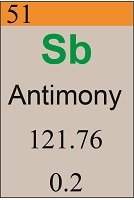
Antimony (Sb):
Antimony is found in a wide variety of environments across Wyoming ranging from metal deposits to pegmatites, heavy mineral placers, paleoplacers, and concretions.
These occurrences overlap the host environments for arsenic and cesium. Any potential for recovery of antimony in Wyoming appears to be in association with other metals, particularly
with silver, lead, and zinc. Antimony associated with silver, copper, lead, and zinc was reported at 10,000 ppm along the Mullen Creek-Nash Fork Shear Zone in the Medicine Bow Mountains.
In general, most deposits are interpreted to be small with little potential for mining as an individual commodity, but may be productively mined in association with other metals.
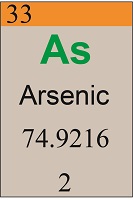
Arsenic (As):
Arsenic occurs in significant concentrations in a variety of environments in Wyoming. Large concentrations (about 1,500 to greater than 10,000 ppm) occur along the north side
of the Mullen Creek layered mafic complex in the Medicine Bow Mountains in association with silver, copper, lead, and zinc mineralization. Arsenic could potentially be produced as a by-product
of processing these metals from the Medicine Bow Mountains, several other Precambrian-cored mountain ranges, and the Great Divide, Wind River, and Bighorn basins, where analyses show
greater than 250 ppm arsenic concentrations.
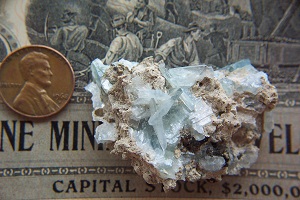
Barite (barium, Ba):
Barite in Wyoming is reported in association with sulfide metal deposits in the cores of several mountain ranges and in a variety of sedimentary and metamorphic
environments where it has been mobilized and redeposited. Known occurrences appear to be small, but further evaluation would be necessary in the case of critical need.
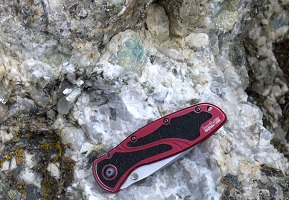
Beryllium (Be):
The only known beryllium occurrences in Wyoming are beryl-hosting pegmatites in several mountain ranges. Between 1928 and 1940, small quantities of beryl
(Be3Al2Si6O18) and tantalite (Fe, Mn)(Ta, Nb)2O6 were mined from the Whippet No. 1 and No. 8 claims in the Copper Mountain district of the Owl Creek Mountains.
Chemical analyses for beryllium are less common than for other elements. Beryllium concentrations in a variety of geologic samples from around Wyoming can be found in the appendix of A Comprehensive Report on Rare Earth Elements in Wyoming.
The potential for beryllium associated with other rock types in Wyoming requires further investigation.
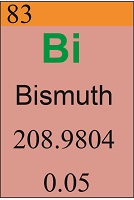
Bismuth (Bi):
Bismuth is found in concentrations greater than 250 ppm in the southern Medicine Bow Mountains, southern Laramie Mountains, and the South Pass area. Lower
concentrations are found in the Sierra Madre, northern Laramie, Granite, Owl Creek, and Absaroka mountains. All occurrences are either associated with other metal deposits or with pegmatites.
While most bismuth is commonly a secondary product from lead refining, a significant amount is also recovered from other metal ores. Potential for bismuth production in Wyoming appears to be
limited to that of a by-product from copper or precious metal ores.

Cesium (Cs):
Cesium occurs in trace amounts in a variety of environments in Wyoming, with a maximum documented concentration of 210 ppm in a pegmatite in the northern Granite
Mountains. Since cesium mining occurs on a very small scale and is very selective; small minable deposits may be a possibility in some pegmatites.
Chromium (Cr):
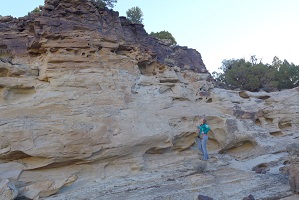
Within the southern Medicine Bow Mountains, chromium concentrations up to 5,000 ppm are associated with shear zones and alterations along the northern edge of the
Mullen Creek layered mafic complex. Slightly lower amounts of chromium in the Medicine Bow Mountains are associated with some shear zones, copper deposits, the Lake Owen layered mafic complex,
and one vermiculite deposit. These chromium occurrences, partly due to their co-occurrence with other metals (Ag, Au, Cu, Ni, and PGEs), have some potential for mining in Wyoming. Other chromium
occurrences are associated with alteration zones in the Granite Mountains. Ultramafic schists, serpentinites, and related rocks host chromium in the Granite, Seminoe, and Laramie mountains,
and the Wind River Mountains near South Pass. Cretaceous paleoplacer black sandstones, primarily in the Mesaverde Group, contain minor amounts of chromium. These paleoplacers, if mined, would be multi-element deposits with accompanying Ti-oxides, zircon, monazite, rutile, rare earth elements, and others.
Chromium is addressed in some WSGS publications including
Geology and Occurrence of Critical Strategic Metals (Chromium, Cobalt, Manganese, and Platinum) in Wyoming;
The Geology of Wyoming’s Precious Metal Lode and Placer Deposits;
Copper, Lead, Zinc, Molybdenum, and Associated Metal Deposits of Wyoming;
Rare Earth Elements In Wyoming,
and
A Comprehensive Report on Rare Earth Elements in Wyoming.
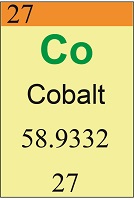
Cobalt (Co):
Cobalt concentrations, associated with copper mineralization and mafic complexes in the Medicine Bow Mountains and the Sierra Madre, are reported as high as 1,000 ppm.
Cobalt also occurs in a silver prospect in the Granite Mountains, small copper deposits in the Ferris Mountains with one reported concentration of 3,000 ppm, and in trace amounts in the Laramie
Mountains.
Cobalt is addressed in some WSGS publications including
Geology and Occurrence of Critical Strategic Metals (Chromium, Cobalt, Manganese, and Platinum) in Wyoming,
The Geology of Wyoming’s Precious Metal Lode and Placer Deposits;
Copper, Lead, Zinc, Molybdenum, and Associated Metal Deposits of Wyoming;
Rare Earth Elements In Wyoming;
and
A Comprehensive Report on Rare Earth Elements in Wyoming
which includes chemical analyses of a variety of geologic samples from around Wyoming.
Cobalt recovery potential in Wyoming is greatest in association with other metals.

Fluorspar or fluorite (fluorine, F):
Wyoming hosts potentially mineable deposits of fluorite in Crook County, where fluorite is concentrated in lenses and mineralized zones within
Mississippian limestone. Smaller occurrences have been reported in Laramie, Carbon, Fremont, and Natrona counties. The WSGS reports that in 1944, mining operations in Wyoming shipped 19 short
tons of fluorite. Fluorine can also be a significant component of phosphate rock, common in western Wyoming.
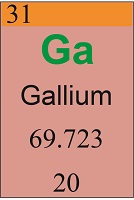
Gallium (Ga):
Gallium is most commonly extracted as a secondary product from zinc and aluminum deposits. This status as a by-product of other ore production means only minor
attention has been paid to possible sources of gallium in Wyoming. Limited analyses show gallium occurs as a trace element in a variety of rocks throughout Wyoming, but no samples contain
enriched concentrations.
Wyoming has no known mineable deposits of gallium.

Germanium (Ge):
Germanium occurs in isolated locations throughout Wyoming, but mineable quantities have not been identified. It is most commonly recovered as a secondary
product from polymetallic deposits, including massive sulfides, copper-lead-zinc, and zinc-lead deposits, as well as from coal. The WSGS analyzed a handful of samples for germanium,
however, only trace amounts were reported.

Graphite (natural) (carbon, C):
Most graphite in Wyoming occurs in Precambrian metamorphic rocks as graphitic schists in relatively thin (1–2 feet thick) veins or as
discontinuous lenses containing 20–50 percent graphite, although many contain less than 20%. A minor amount of graphite was mined in 1926, suggesting additional future mineable potential. Information can be found in the
WGSS publication Graphite in Wyoming.
Also see
Graphite: Western States Mining and Milling Co.,
,
Vaughn Graphite,
Rabbit Creek Graphite,
Geologic Map of the Area Adjacent to the Rabbit Creek Graphite Mine,
and
Preliminary Report on the Rabbit Creek Graphite Deposit, Platte County, Wyoming.
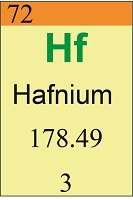
Hafnium (Hf):
Hafnium and zirconium (Zr) are similar physically and chemically and are thus almost always found together, primarily in the minerals zircon (ZrSiO4) and
baddelyite (ZrO2). The Zr:Hf ratio in zircon is about 50:1. The primary source for zircon and baddelyite are paleo-beach placers.
Black-sand paleoplacers, primarily in the Mesaverde Formation (also in several other formations), include as much as 16 percent hafnium-containing zircon. No hafnium or zirconium production has been reported in Wyoming.
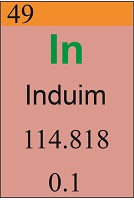
Indium (In):
The majority of indium is produced as a by-product of zinc processing; minimal exploration and production occurs where indium is the primary focus. Indium is commonly extracted from volcanogenic
massive sulfides, sedimentary exhalative deposits, and polymetallic tin deposits. Indium is associated with some copper deposits in the Sierra Madre, the Granite Mountains, and in the Ferris Mountains. Similar to other
critical elements, it has little potential for mining as an individual commodity, but it may have potential to be mined in association with other metals.
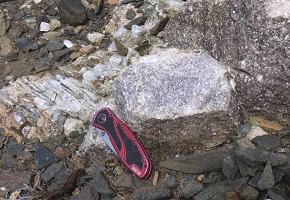
Lithium (Li):
Wyoming hosts minor occurrences of lithium. More information can be found in the 2015 report on lithium resources. A review of more than 26,000 samples of various geomaterials
in Wyoming showed favorable concentrations only in isolated, small, pegmatitic occurrences.
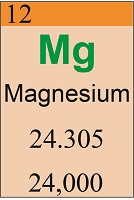
Magnesium (Mg):
Magnesium is produced from seawater, lake brines, dolomite, brucite, magnesite, and olivine. The WSGS reported in Epsomite (Magnesium Sulfate) in Wyoming that epsomite and dolomite deposits had the highest potential for magnesium
extraction in Wyoming, however, the resources have not been fully quantified. Small-scale production of epsomite from lake beds in Albany and Carbon counties was reported in the early 1900s. Magnesium has not been
produced from Wyoming dolostones despite the abundance of this rock type throughout the state.
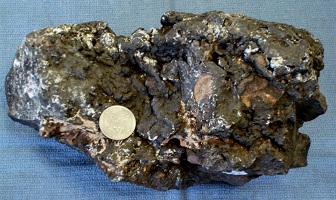
Manganese (Mn):
Manganese ores occur most commonly as supergene or marine sedimentary deposits. In Wyoming, manganese-rich alteration zones are found within a variety of host rocks. Although there are no
known manganese reserves in the state, production of manganese has occurred in the past. In the early half of the 1900s, WSGS records indicate more than 250 tons were extracted from Wyoming. Manganese prospects have
been recorded in Albany, Carbon, Crook, Fremont, Johnson, Natrona, Washakie, and Weston counties. WSGS and U.S. Bureau of Mines analyses from a few of these prospects reveal manganese concentrations ranging from 13 percent
to 50 percent. Manganese is addressed in Geology and Occurrence of Critical Strategic Metals (Chromium, Cobalt, Manganese, And Platinum) in Wyoming.
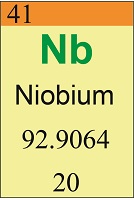
Niobium (Nb):
Niobium occurs most commonly within alkaline and carbonate igneous systems, and is often associated with tantalum as columbite-tantalite (columbite is the niobium-rich endmember).
The WSGS estimates 325 pounds of columbite-tantalite were produced from tin-bearing pegmatites and beryl-rich pegmatites in Wyoming. Prospects have been identified in Albany and Fremont counties, and occurrences
of columbite-tantalite have been reported from Albany, Converse, Crook, and Goshen counties. Niobium is addressed in Columbium (Niobium) and Tantalum in Wyoming,
and chemical analyses of a variety of geologic samples from around Wyoming can be found in the appendix of A Comprehensive Report on Rare Earth Elements in Wyoming.
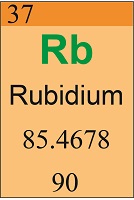
Rubidium (Rb):
Rubidium occurs in favorable concentrations, up to 2,960 ppm, in relatively small, isolated, pegmatites in Wyoming Mountain ranges. Due to its tendency to substitute for other elements such as cesium and lithium, it is produced primarily as a byproduct of cesium, lithium,
and strontium mining operations.
Rubidium is not mined in the United States; mineable potential in Wyoming remains unstudied.
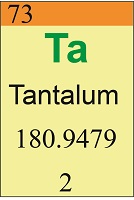
Tantalum (Ta):
Tantalum is primarily extracted from the mineral tantalite, which occurs within granite and pegmatite. Tantalite is often associated with niobium-bearing columbite. The WSGS estimates 325 pounds of columbite-tantalite
were produced from tin-bearing pegmatites and beryl-rich pegmatites in Wyoming, although further details are lacking. In 1942, the WSGS reported a beryl-pegmatite in Fremont County containing
an estimated 2–3 tons of tantalum. Tantalum-bearing minerals were also reported in Precambrian mafic and ultramafic dikes in the Bighorn Mountains.
Tantalum is addressed in
Columbium (Niobium) and Tantalum in Wyoming
and
Tantalum-Bearing Mafic Dikes in The Northern Bighorn Mountains, Sheridan and Big Horn Counties, Wyoming.
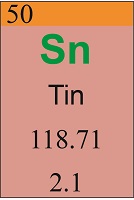
Tin (Sn):
Known tin occurrences in Wyoming are associated with pegmatites, copper-lead-zinc mineralization, and some paleoplacers and modern placers. Some pegmatites and veins in the Black Hills
are tin bearing and are accompanied by minor cassiterite placers. Additional information can be found in
The Geology of Wyoming’s Precious Metal Lode and Placer Deposits,
and
Copper, Lead, Zinc, Molybdenum, and Associated Metal Deposits of Wyoming.
Analysis of a pegmatite sample from Black Mountain, in the Granite Mountains, showed 283 ppm Sn, and a sample from the Babbs
mine in the Ferris Mountains showed 330 ppm; additional information can be found in
Rare Earth Elements in Wyoming
and
A Comprehensive Report on Rare Earth Elements in Wyoming.
Although no mineable tin deposits are known in Wyoming, slightly elevated tin concentrations are found in pegmatites and associated with metals
deposits in the southern Laramie Mountains, the southern Medicine Bow Mountains, the South Pass area, and the Sierra Madre. In addition, paleoplacers in the Mesaverde Formation in several areas of the state host
minor amounts of tin. Titaniferous Black Sandstone Deposits of Wyoming contains further details.
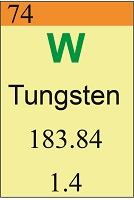
Tungsten (W):
In Wyoming, tungsten occurs primarily in scheelite associated with quartz veins and pegmatites hosted within Precambrian metamorphic rocks. WSGS reports
indicate a small but unknown amount of tungsten ore has been produced and shipped from Wyoming pegmatites. Tungsten is also associated with some copper deposits and alteration zones in igneous, metamorphic,
and sedimentary rocks across the state. Paleoplacers in the Mesaverde Formation, the Frontier Formation, and the Flathead Sandstone host minor amounts of tungsten. Samples from a variety of geologic
environments around Wyoming, analyzed in conjunction with studies of rare earth elements,
showed tungsten in excess of 5,000 ppm in both the southern Laramie Mountains and in the
South Pass area. Additional information can be found in
Rare Earth Elements in Wyoming
and
A Comprehensive Report on Rare Earth Elements in Wyoming.
Tungsten prospects have been
reported in Converse, Fremont, and Washakie counties, with additional occurrences in Albany, Crook, Fremont, Sheridan, and Teton counties. Analyses of samples from some of these
prospects in the 1940's and 1950's showed significant tungsten-trioxide (WO3) concentrations ranging from <1 percent to 4.7 percent, site descriptions indicate limited overall size for the deposits.